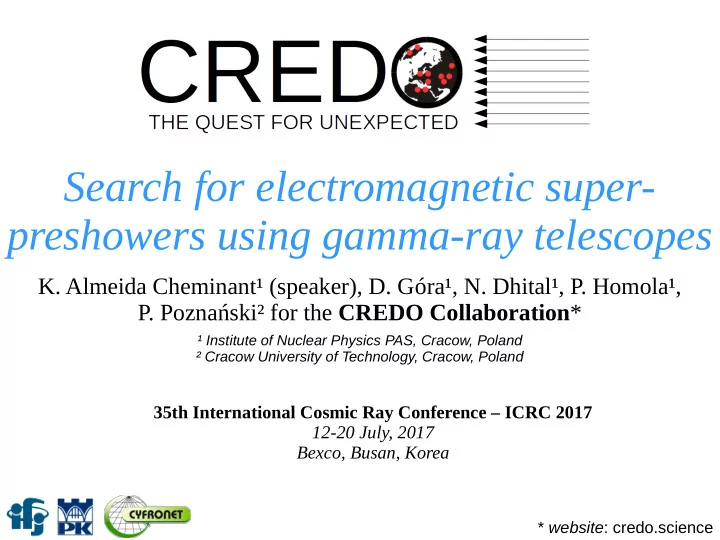

Search for electromagnetic super- preshowers using gamma-ray telescopes K. Almeida Cheminant¹ (speaker), D. Góra¹, N. Dhital¹, P. Homola¹, P. Poznański² for the CREDO Collaboration * ¹ Institute of Nuclear Physics PAS, Cracow, Poland ² Cracow University of Technology, Cracow, Poland 35th International Cosmic Ray Conference – ICRC 2017 12-20 July, 2017 Bexco, Busan, Korea * website : credo.science
Motivations: UHE photons and super-preshowers Niechciol for the Pierre Auger Collab., proc. of ICRC 2017 ➢ Severe constraints for exotic scenarios → limits apply to single ultra-high energy (UHE) photons, assuming no screening [e.g. Lorentz violation with photon decay ( T. Jacobson et al. (2006) ] 2
Motivations: UHE photons and super-preshowers (SPS → Super-preshower) ➢ What if we assume the possibility of cascading processes for UHE photons? Can we observe multiple air showers correlated in time ? → Unique signature! 3
How? C osmic R ay E xtremely D istributed O bservatory: a unifying, global ➢ cosmic-ray project (see ICRC 2017 Proceedings – [PL013]) → wide energy distribution in SPSs: the entire cosmic-ray spectrum is concerned. THIS TALK ➢ Various types of super-preshowers (SPS) based on time and spatial spread. ➢ Pioneer study : detecting type A SPS and UHE photons with Imaging Atmospheric Cherenkov Telescopes (IACTs) 4
Example of screening: Preshower effect ➢ SPS Type A : classical preshower effect ➢ Cascade of electromagnetic particles generated by interaction with geomagnetic field. 5
IACTs and Hillas analysis ➢ Air showers generated by ensembles of photons at the top of the atmosphere → Emission of Cherenkov photons ➢ Detection of Cherenkov photons by IACTs cameras Hillas parameters A. M. Hillas, Proc. of 19th ICRC (1985) M. Sharma et al. (2014) 6
Simulation chain Example with the future Cherenkov Telescope Array (CTA) at La Palma. PRESHOWER photon primary: E=40 EeV, θ=80°, φ=180° 7
Simulation chain Example with the future Cherenkov Telescope Array (CTA) at La Palma. mpi-hd.mpg.de/hfm/HESS PRESHOWER CORSIKA photon primary: (D. Heck, et al. E=40 EeV, θ=80°, φ=180° 1998) Air showers (Options: IACT, QSGJETII, CURVED, etc.) 8
Simulation chain Example with the future Cherenkov Telescope Array (CTA) at La Palma. mpi-hd.mpg.de/hfm/HESS cta-observatory.org/about/array-locations/la-palma/ PRESHOWER CORSIKA Sim_telarray photon primary: (D. Heck, et al. ( K. Bernlöhr 2008) E=40 EeV, θ=80°, φ=180° 1998) Detectors response 4 LSTs Air showers (Options: IACT, 15 MSTs QSGJETII, CURVED, etc.) 9
Longitudinal profiles of Cherenkov light What we see! Gammas Muons Electrons/positrons ➢ Maxima of photon-induced showers deeper in the atmosphere than proton-induced showers (for similar interaction point) ➢ SPSs with higher interaction point (multiple photons): air shower maxima shifted towards proton showers maxima → difficulties in identifying SPSs with current observation modes . ➢ Large zenith angles allow the observation of the muon plateau . → possible identification of SPSs . 10
Images on the camera ➢ SPSs higher interaction point and muon poor: →images are dimmer and smaller in size than in the proton case. →less muon rings. ➢ Multiple air showers initiated by SPSs → new class of events are expected. 11 PROTON SPS
Hillas parameters: preliminary results Top : R IMP =1300m ; Bottom : R IMP =4000m SPS PROTON PHOTON ➢ Potential for event by event discrimination . → cut on multivariate analysis could allow discrimination with low statistics (how many events do we need?). 12
Event rate ➢ Event rate N =φ ( E > E 0 )× A × 4 π 2 A =π R imp E 0 = 40 EeV with and assuming: 1- SHDM I model: N EXP = 0.002 events/hour Niechciol for the Pierre Auger Collab., proc. of ICRC 2017 2- Auger limit: N EXP = 0.00002 events/hour Large time exposure needed! 13
Sensitivity A. Neronov et al., Phys. Rev (2016), astro-ph/1610.01794 ➢ First estimation : Using eq. 7 of Neronov et al. (2016): E 0 GeV cm - ² s -1 sr -1 F min = A Ω K T exp 2 × 19 A =π R imp with in extended observation mode Ω K = 0.1 : duty cycle T exp = 1 year : exposure time − 9 GeV cm - ² s -1 sr -1 F min = 1.33 × 10 14
Conclusion and outlook ➢ Possible discrimination between SPSs and CRs based on a multi- variate analysis and nearly horizontal observations with IACTs. ➢ IACTs sensitivity to photons/SPS at large zenith angles comparable to Pierre Auger Observatory. ➢ Study of SPS type C and D would allow to go lower in energy and reach better sensitivity. ➢ Complete search for super-preshowers: with multi-detector global approach proposed by CREDO ( PL013 this conference ), involving gamma-ray telescopes, cosmic-ray observatories, and neutrino detectors. 15
Recommend
More recommend